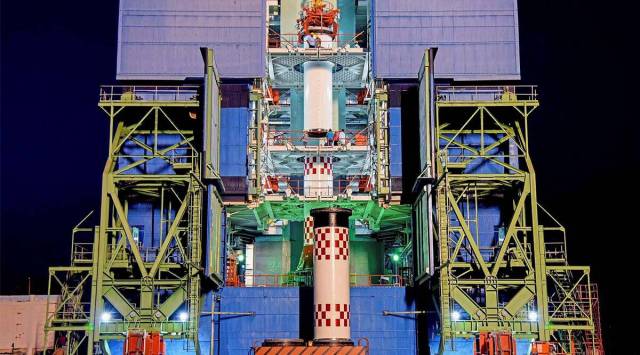- India
- International
Satellites ‘no longer usable’ as ISRO’s first SSLV launch develops glitch
ISRO SSLV launch: While the three solid fuel-based propulsion stages worked normally, the satellites were injected into a wrong orbit, due to failure of logic to identify a sensor failure.
 ISRO's Small Satellite Launch Vehicle mission ferrying an earth observation satellite and a student satellite before its launch. (PTI)
ISRO's Small Satellite Launch Vehicle mission ferrying an earth observation satellite and a student satellite before its launch. (PTI)The maiden flight of ISRO’s newly developed Small Satellite Launch Vehicle (SSLV) suffered a setback on Sunday, with “data loss” at the terminal stage, after three stages had “performed and separated” as planned. The satellites ended up being placed in an elliptical orbit, and are “no longer usable”.
While the three solid fuel-based propulsion stages worked normally, the satellites were injected into a wrong orbit, due to failure of logic to identify a sensor failure.
A statement from the space agency said: “SSLV-D1 placed the satellites into 356 km x 76 km elliptical orbit instead of 356 km circular orbit. Satellites are no longer usable. Issue is reasonably identified. Failure of a logic to identify a sensor failure and go for a salvage action caused the deviation.”
The statement said a committee would look into what had gone wrong and expressed confidence about ISRO coming back “soon” with SSLV-D2.
The applause following the lift-off of SSLV-D1 and successful performance of various stages of the rocket in the mission control room died, at the separation stages of the satellites at 738 and 788 seconds after lift-off, as the scientists realised data losses in the terminal phases.

In a video statement, ISRO Chairperson S Somanath said: “The vehicle took off majestically with the burning of the first stage and the subsequent S2 and S3 performed very well. The performance was very good in the mission and finally when it reached the orbit at an altitude of 356 km, the satellites were separated. However, we subsequently noticed an anomaly in the placement of the satellites in orbit.”
When a satellite is placed in such an orbit, it cannot maintain course for a long time and falls off. “The satellites have already come down from that orbit and they are no longer usable,” Somanath said.
Targeting a new market
While ISRO has already had successful launches of satellites using its Polar Satellite Launch Vehicle and Geosynchronous Satellite Launch Vehicles, it is targeting the SSLV market with this vehicle, which places satellites into the 500-km low Earth orbit.
He added that while a detailed analysis was awaited, they believed a logic that exists in the rocket to identify a sensor had failed. “But for that problem, we couldn’t see any other anomaly. Every other new element that has been incorporated in this rocket performed really well, including the propulsion stages, overall hardware, its aerodynamic designs, new-generation and low-cost electronics, control system, new separation systems, the entire architecture of the rocket… everything has been proven for the very first time in the rocket and we are happy about that,” Somanath said.
He added that they looked forward to the recommendations of the expert panel on why the setback had happened. “We hope that with small corrections and, further, the re-validations of those corrections through an adequate number of tests, we will come back for the next development flight of SSLV-D2 very soon. And we hope that with the second development flight we will become completely successful in proving the vehicle can put satellites in the intended orbits for commercial use for India and the whole world.”
The new rocket was carrying an Indian Earth Observation Satellite, EOS-02, weighing 145 kg and AzaadiSat, made by 750 schoolgirls to celebrate 75 years of Independence under SpaceKidz India, weighing 8 kg.
Newsletter | Click to get the day’s best explainers in your inbox
The SSLV, which uses three solid fuel-based stages and a liquid fuel-based velocity trimming module (VTM) to place a satellite in orbit, was designed keeping in mind the quick turnaround time needed for commercial launches. A launch using the vehicle can be carried out within a week. Somanath told The Indian Express the vehicle can be integrated in two days, tested for the next two, followed by rehearsal and launch in the two days.
This timeline was achieved during the current mission, he said on Saturday.
The lift-off from India’s only spaceport in Sriharikota at 9:18 am was typical of any other launch, and remained so for the first three stages of the vehicle. But there was some deviation from the mapped trajectory during the coasting phase, with the third stage separation, VTM ignition and satellite injection a little delayed from what was mentioned in the space agency’s mission brochure.
More Tech
Apr 24: Latest News
- 01
- 02
- 03
- 04
- 05









































